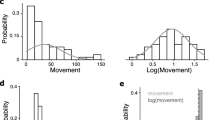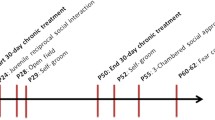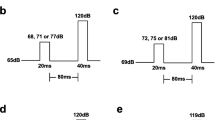Abstract
Autism spectrum disorder (ASD) is a neurodevelopmental disorder, characterized by cognitive and sensorimotor deficits, among others. Hypo-sensitivity and hyper-sensitivity to different stimuli within the same sensory modality, a prominent symptom of ASD, can be assessed by acoustic startle response (ASR) and prepulse inhibition (PPI). Propionic acid (PPA) is a short-chain fatty acid and a by-product of the human gut microbiome. Rodents treated with PPA has been found to produce ASD-related behavioral abnormalities, gastrointestinal discomfort, and conditioned aversions. The present study examined ASR and PPI in adult male rats treated systemically (intraperitoneal injections) with two different doses of PPA. A single injection of PPA produced significant dose-dependent reductions in startle response magnitude relative to control rats. However, PPA-treated rats did not show significant sensorimotor gating abnormalities relative to controls, based on the PPI measures. These findings add to the growing body of evidence supporting the validity of the PPA rodent model of ASD.



Similar content being viewed by others
References
Abrahams B, Geschwind D (2008) Advances in autism genetics: on the threshold of a new neurobiology. Nat Rev Genet 9(5):341–355
Al-Lahham SH, Peppelenbosc MP, Roelofsen H, Vonk RJ, Venema K (2010) Biological effects of propionic acid in humans; metabolism, potential applications and underlying mechanisms. Biochim Biophys Acta (BBA) - Molec Cell Biol Lip 1801(11):1175–1183
Al-Owain M, Kaya N, Al-Shamrani H, Al-Bakheet A, Qari A, Al-Muaigl S, Ghaziuddin M (2012) Autism spectrum disorder in a child with propionic acidemia. J Inherit Metab Dis 7:63–66
Arndt TL, Stodgell CJ, Rodier PM (2005) The teratology of autism. Int J Devel Neurosci 23:189–199
Arpaia N, Campbell C, Fan X, Dikly S, van der Veeken J, deRoos P, Liu H, Cross JR, Pfeffer K, Coffer PJ, Rudensky AY (2013) Metabolites produced by commensal bacteria promote peripheral regulatory T-cell generation. Nature 504:451–455
Baranek GT, Boyd BA, Poe MD, David FJ, Watson LR (2007) Hyperresponsive sensory patterns in young children with autism, developmental delay, and typical development. Am J Ment Retard 112:233–245
Barry RJ, James AL (1988) Coding of stimulus parameters in autistic, retarded, and normal children: evidence for a two-factor theory of autism. Int J Psychophysiol 6:139–149
Belkaid Y, Hand TW (2014) Role of microbiota in immunity and inflammation. Cell 157:121–141
Bilbo SD, Block CL, Bolton JL, Hanamsagar R, Tran PK (2018) Beyond infection - maternal immune activation by environmental factors, microglial development, and relevance for autism spectrum disorders. Exper Neurol 299(Pt.A):241–251
Boyd BA, Baranek GT, Sideris J, Poe MD, Watson LR, Patten E, Miller H (2010) Sensory features and repetitive behaviors in children with autism and developmental delays. Autism Res 3(2):78–87
Brusque AM, Mello CF, Buchanan DN, Terracciano ST, Rocha MP, Vargas CR, Wannmacher CMD, Wajner M (1999) Effect of chemically induced propionic acidemia on neurobehavioral development of rats. Pharmacol Biochem Behav 64:529–534
Choi J, Lee S, Won J, Jin Y, Hong Y, Hur T-Y, Kim J-H, Lee S-R Hong Y (2018) Pathophysiological and neurobehavioral characteristics of a propionic acid-mediated autism-like rat model. PLoS One 13(2):e0192925
Crane L, Goddard L, Pring L. (2009) Sensory processing in adults with autism spectrum disorders. Autism13:215–228
Cromwell HC, Mears RP, Wan L, Boutros NN (2008) Sensory gating: a translational effort from basic to clinical science. Clin EEG Neurosci 39(2):69–72
Dendrinos G, Hemelt M, Keller A (2011) Prenatal VPA exposure and changes in sensory processing by the superior colliculus. Front Integrat Neurosci 5:68
Dufour-Rainfray D, Vourc’h P, Le Guisquet AM, Garreau L, Ternant D, Bodard S, Jaumain E, Gulhan Z, Belzung C, Andres CR, Chalon S, Guilloteau D (2010) Behavior and serotonergic disorders in rats exposed prenatally to valproate: a model for autism. Neurosci Lett 470:55–59
El-Ansary AK, Al-Daihan SK, El-Gezeery AR (2011) On the protective effect of omega-3 against propionic acid-induced neurotoxicity in rat pups. Lipids Health Dis 10:142
El-Ansary AK, Shaker GH, Rizk MZ (2013) Role of gut–brain axis in the aetiology of neurodevelopmental disorders with reference to autism. J Clin Toxicol S6:005
Feliz B, Witt DR, Harris BT (2003) Propionic acidemia: a neuropathology case report and review of prior cases. Arch Pathol Lab Med 127:e325–e328
Foley KA, MacFabe DF, Vaz A. Ossenkopp K-P, Kavaliers M (2014a) Sexually dimorphic effects of prenatal exposure to propionic acid and lipopolysaccharide on social behavior in neonatal, adolescent, and adult rats: implications for autism spectrum disorders. Int J Dev Neurosci 39:68–78
Foley KA, Ossenkopp K-P, Kavaliers M, MacFabe DF (2014b) Pre- and neonatal exposure to lipopolysaccharide or the enteric metabolite, propionic acid, alters development and behavior in adolescent rats in a sexually dimorphic manner. PLoS One 9(1):e87072
Foley KA, MacFabe DF, Kavaliers M, Ossenkopp K-P (2015) Sexually dimorphic effects of prenatal exposure to lipopolysaccharide, and prenatal and postnatal exposure to propionic acid, on acoustic startle response and prepulse inhibition in adolescent rats: relevance to autism spectrum disorders. Behav Brain Res 278:244–256
Frye RE, Melnyk S, MacFabe DF (2013) Unique acyl-carnitine profiles are potential biomarkers for acquired mitochondrial disease in autism spectrum disorder. Transl Psychiat 3:e220
Geyer MA, Swerdlow NR (1998) Measurement of startle response, prepulse inhibition, and habituation. Curr Protoc Neurosci Chap 8: Unit 8:7
Graham FK (1975) The more or less startling effects of weak prestimulation. Psychophysiol 12(3):238–248
Iarocci G, McDonald J (2006) Sensory integration and the perceptual experience of persons with autism. J Autism Dev Disord 36:77–90
Kang DW, Ilhan ZE, Isern NG, Hoyt DW, Howsmon DP, Shaffer M, Lozupone CA, Hahn J, Adams JB, Krajmalnik-Brown R (2018) Differences in fecal microbial metabolites and microbiota of children with autism spectrum disorders. Anaerobe 49:121–131
Kasubuchi M, Hasegawa S, Hiramatsu T, Ichimura A, Kimura I (2015) Dietary gut microbial metabolites, short-chain fatty acids, and host metabolic regulation. Nutrients 7(4):2839–2849
Kirsten TB, Bernardi MM (2017) Prenatal lipopolysaccharide induces hypothalamic dopaminergic hypoactivity and autistic-like behaviors: repetitive self-grooming and stereotypies. Behav Brain Res 331:25–29
Koch M, Schnitzler H (1997) The acoustic startle response in rats—circuits mediating evocation, inhibition and potentiation. Behav Brain Res 89(1–2):35–49
Koh A, De Vadder F, Kovatcheva-Datchary P, Bäckhed F (2016) From dietary fiber to host physiology: short-chain fatty acids as key bacterial metabolites. Cell 165(6):1332–1345
Kohl S, Heekeren K, Klosterkötter J, Kuhn J (2013) Prepulse inhibition in psychiatric disorders – apart from schizophrenia. J Psychiat Res 47(4):445–452
Kohl S, Wolters C, Gruendler TO, Vogeley K, Klosterkötter J, Kuhn J (2014) Prepulse inhibition of the acoustic startle reflex in high functioning autism. PLoS-One 9(3):e92372
Leekam SR, Nieto C, Libby SJ, Wing L, Gould J (2007) Describing the sensory abnormalities of children and adults with autism. J Autism Dev Disord 37:894–910
Lockey AJ, Kavaliers M, Ossenkopp K-P (2009) Lipopolysaccharide produces dose-dependent reductions of the acoustic startle response without impairing prepulse inhibition in male rats. Brain Behav Immun 23:101–107
MacFabe DF (2012) Short-chain fatty acid fermentation products of the gut microbiome: implications in autism spectrum disorders. Microb Ecol Health Dis 23:19260
MacFabe DF, Cain D, Rodriguez-Capote K, Franklin A, Hoffman JE, Boon F, Kavaliers M, Ossenkopp K-P (2007) Neurobiological effects of intraventricular propionic acid in rats: possible role of short chain fatty acids on the pathogenesis and characteristics of autism spectrum disorders. Behav Brain Res 176(1):149–169
MacFabe DF, Rodriguez-Capote K, Hoffman JE, Franklin AE, Mohammad-Asef Y, Taylor RA, Boon F, Cain DP, Kavaliers M, Possmayer F, Ossenkopp K-P (2008) A novel rodent model of autism: Intraventricular infusions of propionic acid increase locomotor activity and induce neuroinflammation and oxidative stress in discrete regions of adult rat brain. Amer J Biochem Biotech 4:146–166
MacFabe DF, Cain N, Boon F, Ossenkopp K-P, Cain DP (2011) Effects of the enteric bacterial metabolic product propionic acid on object-directed behavior, social behavior, cognition, and neuroinflammation in adolescent rats: relevance to autism spectrum disorder. Behav Brain Res 217:47–54
Madsen GF, Bilenberg N, Cantio C, Oranje B (2014) Increased prepulse inhibition and sensitization of the startle reflex in autistic children. Autism Res 7(1):94–103
Marco EJ, Hinkley LB, Hill SS, Nagarajan SS (2011) Sensory processing in autism: a review of neurophysiologic findings. Pediatr Res 69:48R–54R
Müller R, Cauich C, Rubio MA, Mizuno A, Courchesne E (2004) Abnormal activity patterns in premotor cortex during sequence learning in autistic patients. Biol Psychiatry 56(5):323–332
Ornitz EM, Lane SJ, Sugiyama T, De TJ (1993) Startle modulation studies in autism. J Autism Dev Disord 23:619–637
Ossenkopp K-P, Foley KA, Gibson J, Fudge MA, Kavaliers M, Cain DP, MacFabe DF (2012) Systemic treatment with the enteric bacterial fermentation product, propionic acid, produces both conditioned taste avoidance and conditioned place avoidance in rats. Behav Brain Res 227(1):134–141
Pierre K, Pellerin L (2005) Monocarboxylate transporters in the central nervous system: distribution, regulation and function. J Neurochem 94:1–14
Rafiki A, Boulland J, Halestrap A, Ottersen O, Bergersen L (2003) Highly differential expression of the monocarboxylate transporters MCT2 and MCT4 in the developing rat brain. Neurosci 122(3):677–688
Reynolds S, Millette A, Devine DP (2012) Sensory and motor characterization in the postnatal valproate rat model of autism. Dev Neurosci 34(2–3):258–267
Rogers SJ, Ozonoff S (2005) Annotation: what do we know about sensory dysfunction in autism? A critical review of the empirical evidence. J Child Psychol Psychiat 46:1255–1268
Rogers SJ, Hepburn S, Wehner E (2003) Parent reports of sensory symptoms in toddlers with autism and those with other developmental disorders. J Autism Dev Disord 33:631–642
Rörig B, Klausa G, Sutor B (1996) Intracellular acidification reduced gap junction coupling between immature rat neocortical pyramidal neurones. J Physiol 490(1):31–49
Schneider T, Przewłocki R (2005) Behavioral alterations in rats prenatally exposed to valproic acid: animal model of autism. Neuropsychopharm 30(1):80–89
Shams S, Foley KA, Kavaliers M, MacFabe DF, Ossenkopp K-P (2018) Systemic treatment with the enteric bacterial metabolic product propionic acid results in reduction of social behavior in juvenile rats: Contribution to a rodent model of autism spectrum disorder. Develop Psychobiol DEV-18-103, in revision
Shultz SR, MacFabe DF, Ossenkopp K, Scratch S, Whelan J, Taylor R, Cain DP (2008) Intracerebroventricular injection of propionic acid, an enteric bacterial metabolic end-product, impairs social behavior in the rat: implications for an animal model of autism. Neuropharm 54(6):901–911
Shultz SR, MacFabe DF, Ossenkopp K-P, Scratch S, Whelan J, Taylor R, Cain DP (2009) Intracerebroventricular injections of propionic acid impair cognition and sensorimotor ability in adult male rats. Behav Brain Res 200:33–41
De Vadder F, Kovatcheva-Datchary P, Goncalves D, Vinera J, Zitoun C,Duchampt A, Bäckhed F, Mithieux G (2014) Microbiota-generated metabolites promote metabolic benefits via gut–brain neural circuits. Cell 156:84–96
Vorhees CV (1987) Behavioral teratogenicity of valproic acid: selective effects on behavior after prenatal exposure to rats. Psychopharm 92(2):173–179
Wang L, Christophersen CT, Sorich MJ, Gerber JP, Angley MT, Conlon MA (2012) Elevated fecal short chain fatty acid and ammonia concentrations in children with autism spectrum disorder. Digest Dis Sci 57:2096–2102
Funding
This research was supported by Discovery grants and Research Tools and Instruments grants from the Natural Sciences and Engineering Research Council of Canada (NSERC) awarded to M. Kavaliers and K.-P. Ossenkopp.
Author information
Authors and Affiliations
Corresponding author
Ethics declarations
All procedures were approved by the Western University Animal Care Committee and were in accordance with the guidelines of the Canadian Council of Animal Care.
Conflict of Interest
The authors declare that they have no conflicts of interest.
Rights and permissions
About this article
Cite this article
Kamen, C.L., Zevy, D.L., Ward, J.M. et al. Systemic Treatment with the Enteric Bacterial Fermentation Product, Propionic Acid, Reduces Acoustic Startle Response Magnitude in Rats in a Dose-Dependent Fashion: Contribution to a Rodent Model of ASD. Neurotox Res 35, 353–359 (2019). https://doi.org/10.1007/s12640-018-9960-9
Received:
Revised:
Accepted:
Published:
Issue Date:
DOI: https://doi.org/10.1007/s12640-018-9960-9




